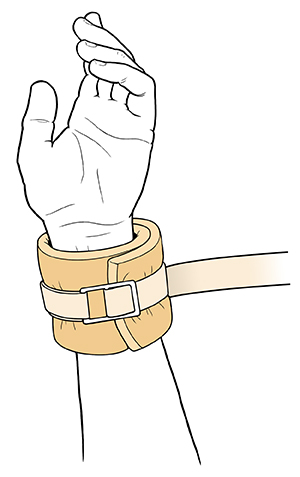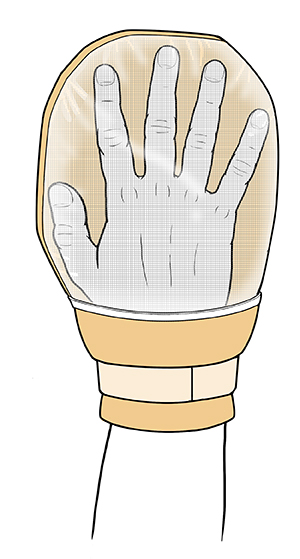Understanding Restraints
Restraints help keep patients as safe when they could injure themselves. This handout may help answer some of your questions. Talk with your healthcare provider if you have other questions or concerns.
 |
| Wrist restraints keep a patient from pulling tubes out. |
 |
| Mitts prevent scratching at wounds or bandages. |
Why restraints are used
Some medicines or illnesses can cause confusion. A patient may not remember where they are or why they are there. Restraints help keep patients from harming themselves. Restraints can help prevent such things as:
-
Wandering out of a safe area
-
Removing tubes or bandages
-
Scratching at wounds or bandages
-
Injuring themselves
-
Injuring others
How restraints are used
Many types of restraints are available. Each type has a purpose. Very strict guidelines say how a restraint can be used and for how long. Healthcare providers must:
-
Assess and document why the restraint is needed. They must follow current practice and guidelines.
-
Explain to the patient what is happening and why
-
Use restraints only after all other other methods have been tried. They must gather a team to apply the restraints.
-
Choose the restraint that limits movement the least
-
Check the skin under the restraint often
-
Keep a call button within the patient’s reach when a restraint is in place
-
Remove the restraint as soon as it's no longer needed
-
Preserve the patient’s dignity
How you can help
-
Know that your loved one will be helped in doing everything they need. This includes eating, bathing, and using the toilet.
-
Don't hesitate to ask your loved one's healthcare team about the restraints. Ask why they are used. Ask how long they will be needed.
-
Never remove restraints or loosen them yourself. Talk with your loved one's healthcare provider if you have a concern.
© 2000-2024 The StayWell Company, LLC. All rights reserved. This information is not intended as a substitute for professional medical care. Always follow your healthcare professional's instructions.